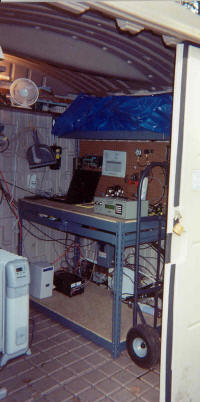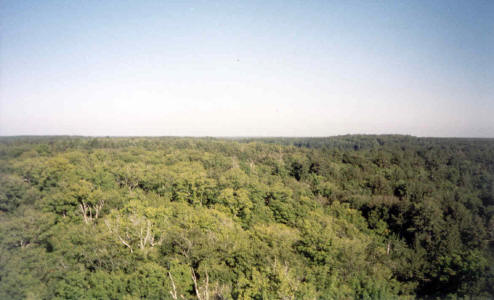 |
 |
 |
|
|
|
|
Site
Description and Maps | Photographs |
Basic measurements | Equipment and Methods |
View plots | Download data |
Publications and Presentations |
Contacts |
Links |
ChEAS Home
Page
SITE
DESCRIPTION
Location: Tower location (GPS, taken in 8/2001): 46° 14'
31.26'' N, 89° 20' 51.54'' W
(click here for
maps)
The site is within the 8,500 hectare Sylvania Tract of the Ottawa
National Forest, one of only two remaining large tracts of old growth forest in
the Great Lakes region. The tower is adjacent to the Sylvania Wilderness
Area.
Elevation: At tower base: 500 m / 1650 ft above mean sea level (GPS altitude, 8/2001)
Annual average precipitation/snowfall (Marquette, MI, 1961-1990): 89.6 / 320.5 cm (snowfall is less near site due to diminished lake effect)
Annual average temperature (Marquette, MI, 1961-1990): 3.9°C
Stand age: Trees range in age from
current year regeneration to > 350 years old. Large, old trees make up a
significant component of the canopy.
Species composition: Dominant species present on the site are basswood
(Tilia americana), eastern hemlock (Tsuga canadensis), ironwood (Ostrya
virginiana), sugar maple (Acer saccharum), and yellow birch (Betula
alleghaniensis). Only limited, selected logging of white pine has
occurred near lake shores. The site pairs well with
Willow Creek, WI as a successional stage comparison because the
presettlement vegetation on both sites was the same.
Average canopy height: 26-27 m, tower height is 37 m
Average leaf area index (LAI): 4.06 in sugar maple-dominated patches, 3.79 in hemlock-dominated patches
Research objectives: 1.) Characterize the net ecosystem exchange (NEE) of carbon of an undisturbed old-growth forest. 2.) Quantify the relative response of old-growth versus regrowing forests to climate variability and climate change. 3.) Determine to what degree component carbon fluxes differ between early and late successional stands thereby examining the role of stand age as a determining factor of atmospheric CO2 storage.
Funding Agency: Department of Energy, Terrestrial Carbon Processes
Established: August 2001
PHOTOGRAPHS (Click here to see additional
photos!
)
 |
 |
 |
|
|
|
|
 |
 |
|
|
|
CO2 and H2O Fluxes at 36 m
CO2 mixing ratio profile (36 m, 21 m, 14 m, 7.6 m, 3 m, 1.8 m, 0.6 m)
H2O mixing ratio profile (36 m, 20 m, 10 m, 2 m)
Above canopy radiation (36 m)
Net incoming radiation
Photosynthetically active radiation (incoming direct)
Below canopy radiation
Surface photosynthetically active radiation (2 sites)
Air temperature profile (36 m, 30 m, 24 m, 20 m, 18 m, 12 m, 10 m, 6 m, 2 m, 0.6 m)
Air temperature profile above soil (100 cm, 50 cm, 25 cm, 5 cm)
Soil temperature and moisture profile (surface, 5, 10, 25, 50, 100 cm), surface soil temperature array, tree bole temperature array
Wind speed/direction profile (36 m, 20 m)
Soil heat flux (7.5 cm)
Leaf wetness indicator (36 m)
Precipitation - rain (2 locations - above canopy and below canopy) with snowfall adapter (above canopy only)
Tree transpiration / sapflux on 48 trees
Soil, stem/bole, leaf respiration chambers, collars and cuvettes
Forest characterization (species, dbh, height, LAI), dendrometer bands to measure growth
EQUIPMENT AND
METHODS
Rohn 45G tower (120 ft)
(4) canopy access scaffolding towers (40-70 ft)
CSI CR23X datalogger, 4 Mb
extended memory
CSI CR10X datalogger, 2 Mb extended
memory (2)
CSI AM416 multiplexers
LI-COR 6262
(CO2/H2O fluxes) and 6252 (CO2 profile) and 6400
(respiration/photosynthesis measurements)
KNF UN89DCB-12V brushless DC
diaphragm pumps, ¼" (od) Bev-a-Line
IX, Teflon, or Dekabon 1300 tubing, and Gelman Acro 50
teflon inlet filters
High precision CO2 profiler (see
Peter Bakwin et al., 1998, Tellus
50B:401-415)
CSI CSAT3 3D Sonic anemometer
Campbell / Vaisala HMP45C
temperature/humidity probes
Vaisala PTB101B analog barometer
Kipp & Zonen NR-LITE net radiometer (above canopy)
CSI model 237
leaf wetness sensor
Type T thermocouples (soil/tree temperatures; air
temperatures from 0.25 to 2 m)
CSI 10TCRXTCR Thermocouple
reference thermistor
REBS HFT-3 soil heat flux plate
CSI CS615 Soil
water content reflectometer probes
Kipp and Zonen Quantum sensors
(PAR)
RM Young model 03002 wind sentries
Texas Electronics 6" tripping bucket rain gauge with CSI
CS705 snowfall adapter
CSI Rad-Haul and SC532 interfaces
Micron PC and Iomega 250 Mb Zip drive, running Windows 98, Symantec PC Anywhere,
Campbell PC 208W
Campbell COM100 Cellular telephone package: Motorola Analog
Phone and Transceiver connected to 56K modem
Yagi 12 db antenna
200 Amp AC Utility power, APC Line
Conditioner, 20 Amp DC power supply
Sampling Frequencies:
0.1 second - eddy
covariance measurements (wind speed/direction, CO2, H2O)
1 second - radiation, air temperature,
H2O mixing ratio,
barometric pressure,
canopy PAR, net rad, wind speed/direction
air temperature/humidity,
leaf wetness
(all are output with 1 minute average)
10 minutes - air & soil temperatures, soil moisture, soil heat
flux, total precipitation in interval
21
minutes - interval between profile CO2 measurements for any level
Standards and
Calibration:
CO2standards - 330, 440, 550 ppm CO2 in dry air (calibrated using 330 and 550 ppm NOAA primary
standards).
CO2 mixing ratio - LI-6252
zeroed every 42 minutes, calibrated with 3 standards every 4
hours.
CO2 and H2O flux - LI-6262 continuously calibrated
with LI-6251 and Vaisala humidity measurement.
VIEW PLOTS (You will need Adobe Acrobat and/or Ghost View to view these plots)
Flux and meteorology data analyses (functional fits, gap-filled time
series, u* plots, ensemble averages, cumulative NEE, etc...) - see
analyses.txt for descriptions
2001 |
2002 |
2003 |
2004 |
2005 |
2006
Sapflux, bole temperature, soil temperature, soil respiration, bole respiration, leaf photosynthesis available on request to Ankur Desai <adesai@meteo.psu.edu>.
Remote sensing imagery (MODIS, etc...), model output, micromet data, turbulent flux plots, contact Ankur Desai <adesai@meteo.psu.edu>.
30-minute
average of all flux and meteorology data (one year files) ASCII and Binary
versions available. Please see
readme
files for format
2001
| 2002
| 2003 |
2004 |
2005 |
2006
Higher frequency data (1 or 10 minute meteorology, 10 Hz flux data) can be made available on request to Ankur Desai <adesai@meteo.psu.edu>.
Sapflux, bole temperature, soil temperature, soil respiration, bole respiration, leaf photosynthesis and general ecological measurements (dbh, species, size class, tree growth, etc...) can be made available on request to Ankur Desai <adesai@meteo.psu.edu>.
Ankur Desai's consolidated field notes
PUBLICATIONS AND PRESENTATIONS
Desai, A.R., Bolstad, P.V., Cook, B.D., Davis, K.J., and Carey, E.V., 2005. Comparing net ecosystem exchange of carbon dioxide between an old-growth and mature forest in the upper midwest, USA. Ag. For. Met. 128(1-2): 33-55 (doi: 10.1016/j.agrformet.2004.09.005) (Adobe Acrobat PDF)
December 2003 presentation at American Geophysical Union Fall Meeting, San Francisco, CA by Ankur Desai (Microsoft Powerpoint)
October 2003 poster presented at Ameriflux meeting, Boulder, CO by Ankur Desai (Adobe Acrobat PDF)
June 2003 presentation at the ChEAS 2003 meeting, Woodruff, WI by Ankur Desai (Microsoft Powerpoint)
May 2003 poster presented at North American Carbon Program PI meeting, Arlington, VA by Eileen Carey (Adobe Acrobat PDF)
October 2002 poster presented at Ameriflux meeting, Boulder, CO by Eileen Carey (JPEG)
January 2002 lab group presentation by Ankur Desai (PSU) (HTML | Microsoft Powerpoint)
CONTACTS (click on names for detailed contact information)
Paul Bolstad (pbolstad@umn.edu), Principal Investigator
Ken Davis (davis@met.psu.edu), Co-Investigator
Ankur Desai (adesai@meteo.psu.edu), Ph.D., Penn State - Meteorology (eddy covariance and micromet, website and ftp)
Ron Teclaw (rteclaw@fs.fed.us), Biologist, U.S. Forest Service - North Central Research Station (site field support)
Dan Baumann (dbaumann@fs.fed.us), Forestry Technician, U.S. Forest Service - North Central Research Station (site field support)
Roger Dahlman (roger.dahlman@science.doe.gov), Program Manager, Department of Energy, Terrestrial Carbon Processes (funding agency)
If you have comments or questions about this page, please email Ankur Desai